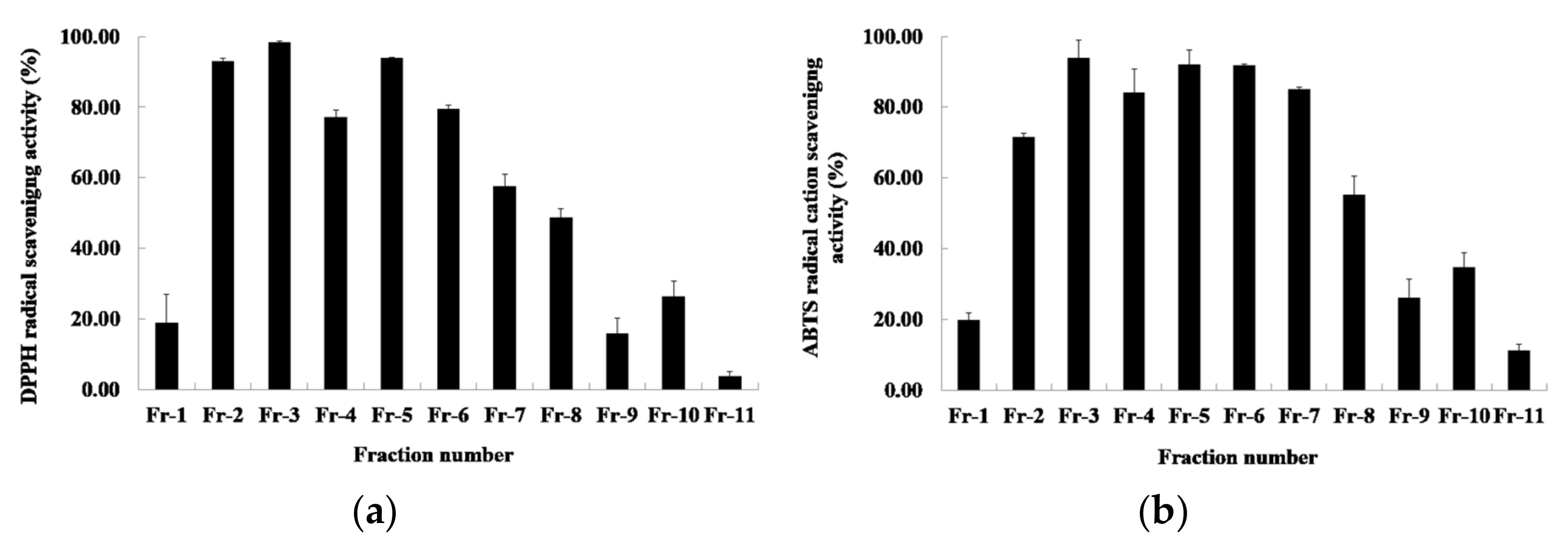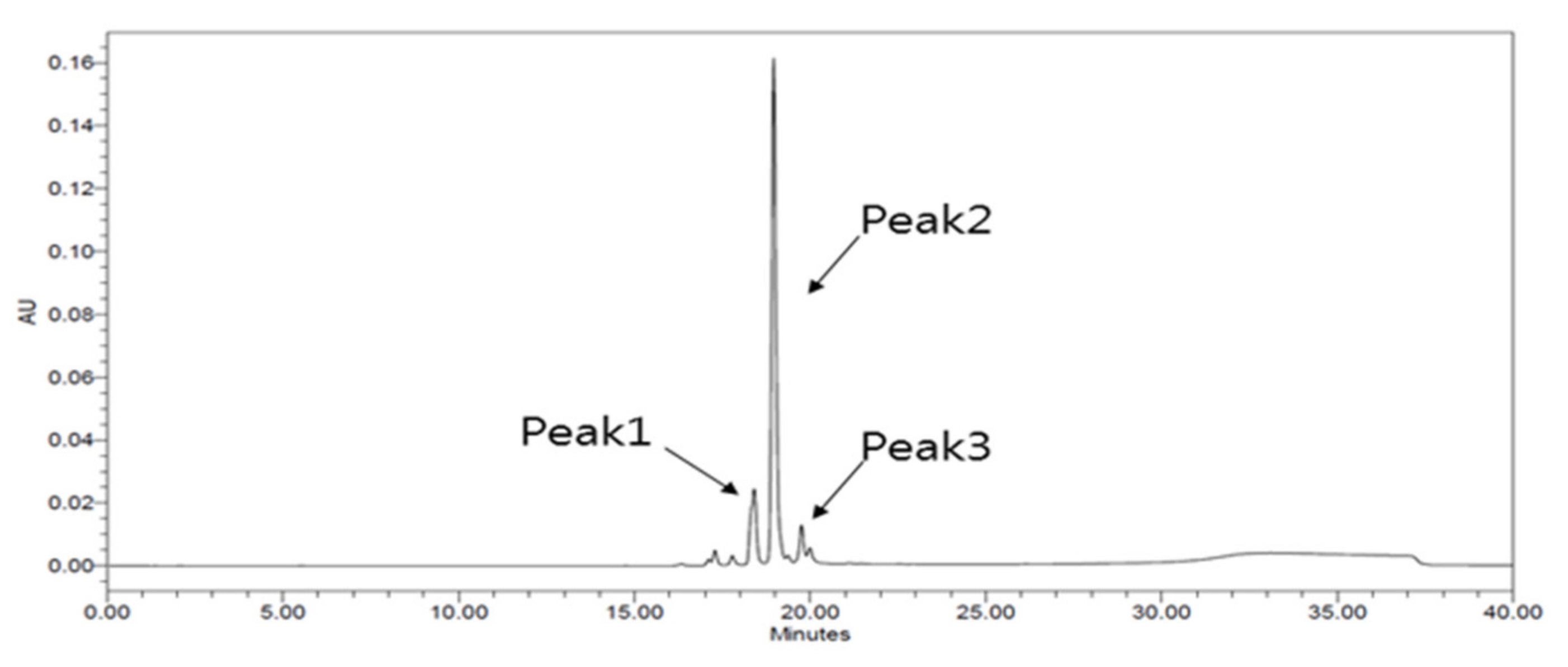Isolation and Identification of Fisetin: An Antioxidative Compound Obtained from Rhus verniciflua Seeds
Abstract
1. Introduction
2. Results and Discussion
2.1. Antioxidant Activity by Different Solvent Fractions
2.2. Antioxidant Activities of the Primary Fractions
2.3. Antioxidant Activities of Secondary Fractions
2.4. Antioxidant Activities of HPLC Fractions
2.5. Identification of Fraction Peak Number 2’s Substances by Liquid Chromatography–Mass Spectrometry (LC-MS), NMR, and HPLC
3. Materials and Methods
3.1. Materials and Chemicals
3.2. Preparation of R. Verniciflua Seed Extracts Using 50% Ethanol as a Solvent
3.3. DPPH Radical-Scavenging-Activity Assays
3.4. ABTS Radical-Scavenging-Activity Assays
3.5. Superoxide Dismutase (SOD) Assays
3.6. Separation by Different Solvent Fractions
3.7. Separation by Silica-Gel Column Chromatography
3.8. Separation by High-Performance Liquid Chromatography (HPLC)
3.9. Identification of Fraction Peak 2 Substance by HPLC–Mass Spectrometry (MS)
3.10. Identification of Antioxidant Active Substances by Nuclear Magnetic Resonance (NMR)
3.11. Identification of Active Antioxidant Substances by HPLC
4. Conclusions
Supplementary Materials
Author Contributions
Funding
Institutional Review Board Statement
Informed Consent Statement
Data Availability Statement
Conflicts of Interest
References
- Lee, W.G.; Kim, M.J.; Heo, G. Phylogeny of Korean Rhus spp. Based on ITS and rbcL Sequences. Korean J. Med. Crop. Sci. 2004, 12, 60–66. [Google Scholar]
- Lim, J.W.; Shin, S.M.; Jung, S.J.; Lee, M.K.; Kang, S.Y. Optimization of antibacterial extract from lacquer tree (Rhus verniciflua Stokes) using response surface methodology and its efficacy in controlling edwardsiellosis of olive flounder (Paralichthys olivaceus). Aquaculture 2019, 502, 40–47. [Google Scholar] [CrossRef]
- KIOM (Korea Institute of Oriental Medicine). Korean Medicinal Materials. 2017, Volume 3, pp. 16–19. Available online: http://herba.kr/boncho/?m=dogam&v=3 (accessed on 25 April 2022).
- KIOM (Korea Institute of Oriental Medicine). Korean Traditional Medicine Knowledge Database. 2015. Available online: https://mediclassics.kr (accessed on 25 April 2022).
- Choi, H.S.; Kim, B.H.; Yeo, S.H.; Jeong, S.T.; Choi, J.H.; Park, H.S.; Kim, M.K. Physicochemical properties and physiological activities of Rhus verniciflua stem bark cultured with Fomitella fraxinea. Korean J. Mycol. 2010, 38, 172–178. [Google Scholar] [CrossRef]
- Cho, Y.M.; Jung, Y.K.; Kim, J.S.; Lee, J.B.; Paeng, K.J. The analysis of the urushiol congeners from the extracts of lacquer trees. Anal. Sci. Technol. 2009, 22, 65–74. [Google Scholar]
- Chen, H.; Wang, C.; Zhou, H.; Tao, R.; Ye, J.; Li, W. Antioxidant capacity and identification of the constituents of ethyl acetate fraction from Rhus verniciflua stokes by HPLC-MS. Nat. Prod. Res. 2017, 31, 1573–1577. [Google Scholar] [CrossRef] [PubMed]
- Symes, W.F.; Dawon, C.R. Poison Ivy ‘Urushiol’. J. Am Chem. Soc. 1954, 76, 2959–2963. [Google Scholar] [CrossRef]
- Gladman, A.C. Toxicodendron Dermatitis: Poison Ivy, Oak, and Sumac. Wilderness Environ. Med. 2006, 17, 120–128. [Google Scholar] [CrossRef]
- Cho, N.; Choi, J.H.; Yang, H.J.; Jeong, E.J.; Lee, K.Y.; Kim, Y.C.; Sung, S.H. Neuroprotective and anti-inflammatory effects of flavonoids isolated from Rhus verniciflua in neuronal HT22 and microglial BV2 cell. Food Chem. Toxicol. 2012, 50, 1940–1945. [Google Scholar] [CrossRef]
- Jeon, W.K.; Lee, J.H.; Kim, H.K.; Lee, A.Y.; Lee, S.O.; Kim, Y.S.; Ryu, S.Y.; Kim, S.Y.; Lee, Y.J.; Ko, B.S. Anti-platelet effects of bioactive compounds isolated from the bark of Rhus verniciflua Stokes. J. Ethnopharmacol. 2006, 106, 62–69. [Google Scholar] [CrossRef]
- Kwak, E.J.; Jo, I.J.; Sung, K.S.; Ha, T.Y. Effect of Hot Water Extracts of Roasted Rhus verniciflua Stokes on Antioxidant Activity and Cytotoxicity. J. Korean Soc. Food Sci. Nutr. 2005, 34, 784–789. [Google Scholar] [CrossRef]
- Chen, H.; Wang, C.; Ye, J.; Zhou, H.; Yuan, J. Phenolic extracts from Rhus verniciflua stokes bark by decompressing inner ebullition and their antioxidant activities. Nat. Prod. Res. 2014, 28, 496–499. [Google Scholar] [CrossRef] [PubMed]
- Son, Y.O.; Lee, K.Y.; Lee, J.C.; Jang, H.S.; Kim, J.G.; Jeon, Y.M.; Jang, Y.S. Selective antiproliferative and apoptotic effects of flavonoids purified from Rhus verniciflua Stokes on normal versus transformed hepatic cell lines. Toxicol. Lett. 2005, 155, 115–125. [Google Scholar] [CrossRef] [PubMed]
- Hoang, T.H.; Yoon, Y.; Park, S.A.; Lee, H.Y.; Peng, C.; Kim, J.H.; Lee, G.H.; Chae, H.J. IBF-R, a botanical extract of Rhus verniciflua controls obesity in which. J. Funct. Foods 2021, 87, 104804. [Google Scholar] [CrossRef]
- Park, K.Y.; Jung, G.O.; Lee, K.T.; Choi, J.W.; Choi, M.Y.; Kim, G.T.; Jung, H.J.; Park, H.J. Antimutagenic activity of flavonoids from the heartwood of Rhus verniciflu. J. Ethnopharmacol. 2004, 90, 73–79. [Google Scholar] [CrossRef] [PubMed]
- Choi, H.S.; Yeo, S.H.; Jeong, S.T.; Choi, J.H.; Park, H.S.; Kim, M.K. Preparation and Characterization of Urushiol Free Fermented Rhus verniciflua Stem Bark (FRVSB) Extracts. Korean J. Food. Sci. Technol. 2012, 44, 173–178. [Google Scholar] [CrossRef][Green Version]
- Baek, S.Y.; Lee, C.H.; Park, Y.K.; Choi, H.S.; Mun, J.Y.; Yeo, S.H. Quality characteristics of fermented vinegar prepared with the detoxified Rhus verniciflua extract. Korean J. Food Preserv. 2015, 22, 674–682. [Google Scholar] [CrossRef]
- Choi, H.S.; Jeong, S.T.; Choi, J.H.; Kang, J.E.; Kim, E.G.; Noh, J.M.; Kim, M.K. Effect of Urushiol-Free Extracts from Fermented-Rhus verniciflua Stem Bark with Fomitella fraxinea on the Fermentation Characteristics of Doenjang (Soybean Paste). Korean J. Mycol. 2013, 40, 244–253. [Google Scholar] [CrossRef]
- Jin, H.Y.; Moon, H.J.; Kim, S.H.; Lee, S.C.; Huh, C.K. Quality characteristics of blended tea with added pan-firing Rhus verniciflua seeds and changes in its antioxidant activity during storage. Korean J. Food Sci. Technol. 2017, 49, 318–323. [Google Scholar] [CrossRef]
- Jin, H.Y.; Choi, Y.J.; Moon, H.J.; Jeong, J.H.; Nam, J.H.; Lee, S.C.; Huh, C.K. Antioxidant activities of Rhus verniciflua seed extract and quality characteristics of fermented milk containing Rhus verniciflua seed extract. Korean J. Food Preserv. 2016, 23, 825–831. [Google Scholar] [CrossRef][Green Version]
- Boukhary, R.; Aboul-ElA, M.; Al-Hanbali, O.; El-Lakany, A. Phenolic Compounds from Centaurea horrida L. Growing in Lebanon. Int. J. Pharmacogn. Phytochem. Res. 2017, 9, 1–4. [Google Scholar] [CrossRef]
- Tsunekawa, R.; Hanaya, K.; Higashibayashi, S.; Sugai, T. Synthesis of fisetin and 2′,4′,6′-trihydroxydihyrochalcone 4′-O-β-neohesperidoside based on site-selective deacetylation and deoxygenation. Biosci. Biotechnol. Biochem. 2018, 28, 1316–1322. [Google Scholar] [CrossRef] [PubMed]
- Suh, Y.; Afaq, F.; Johnson, J.J.; Mukhtar, H. A plant flavonoid fisetin induces apoptosis in colon cancer cells by inhibition of COX2 and Wnt/EGFR/NF-kB-signaling pathways. Carcinogenesis 2009, 30, 300–307. [Google Scholar] [CrossRef] [PubMed]
- Park, H.J.; Kwon, S.H.; Kim, G.T.; Lee, K.T.; Choi, J.H.; Choi, J.; Park, K.Y. Physicochemical and biological characteristics of flavonoids isolated from the heartwoods of Rhus verniciflua. Korean J. Pharmacogn. 2000, 31, 345–350. [Google Scholar]
- Kashyap, D.; Sharma, A.; Sak, K.; Tuli, H.S.; Buttar, H.S.; Bishayee, A. Fisetin: A bioactive phytochemical with potential for cancer prevention and pharmacotherapy. Life Sci. 2018, 194, 75–87. [Google Scholar] [CrossRef]
- Sakai, E.; Shimada-Sugawara, M.; Yamaguchi, Y.; Sakamoto, H.; Fumimoto, R.; Fukuma, Y.; Nishishita, K.; Okamoto, K.; Tsukuba, T. Fisetin inhibits osteoclastogenesis through prevention of RANKL-induced ROS production by Nrf2-mediated up-regulation of phase II antioxidant enzymes. J. Pharmacol. Sci. 2013, 121, 288–298. [Google Scholar] [CrossRef] [PubMed]
- Maurya, B.K.; Trigun, S.K. Fisetin modulates antioxidant enzymes and inflammatory factors to inhibit aflatoxin-B1 induced hepatocellular carcinoma in rats. Oxid. Med. Cell. Longev. 2015, 2016, 1972793. [Google Scholar] [CrossRef] [PubMed]
- Syed, D.N.; Adhami, V.M.; Khan, K.; Khan, M.I.; Mukhtar, H. Exploring the molecular targets of dietary flavonoid fisetin in cancer. Semin. Cancer. Biol. 2016, 40, 130–140. [Google Scholar] [CrossRef] [PubMed]
- Khan, N.; Mukhtar, H. Dietary agents for prevention and treatment of lung cancer. Cancer Lett. 2015, 359, 155–164. [Google Scholar] [CrossRef]
- Khan, N.; Asim, M.; Afaq, F.; Zaid, M.A.; Mukhtar, H. A novel dietary flavonoid fisetin inhibits androgen receptor signaling and tumor growth in athymic nude mice. Cancer Res. 2018, 68, 8555–8563. [Google Scholar] [CrossRef]
- Kim, S.G.; Rhyu, D.Y.; Kim, D.K.; Ko, D.H.; Kim, Y.K.; Lee, Y.M.; Jung, H.J. Inhibitory effect of heartwood of Rhus verniciflua stokes on lipid accumulation in 3T3-L1 cells. Korean J. Pharmacogn. 2010, 41, 21–25. [Google Scholar]
- Blois, M.S. Antioxidant determination by the use of a stable free radical. Nature 1958, 181, 1199–1200. [Google Scholar] [CrossRef]
- Re, R.; Pellegrini, N.; Proteggente, A.; Pannala, A.; Yang, M.; Rice-Evans, C. Antioxidant activity applying an improved ABTS radical cation decolorization assay. Free Radic. Biol. Med. 1999, 26, 1231–1237. [Google Scholar] [CrossRef]
- McCord, J.M.; Fridovich, I. Superoxide dismutase: An enzymic function for erythrocuprein (hemocuprein). J. Biol. Chem. 1969, 244, 6049–6055. [Google Scholar] [CrossRef]
- Lee, W.J.; Kang, J.E.; Choi, J.H.; Jeong, S.T.; Kim, M.K.; Choi, H.S. Comparison of the flavonoid and urushiol content in different parts of Rhus verniciflua stokes grown in wonju and okcheon. Korean J. Food Sci. Technol. 2015, 47, 158–163. [Google Scholar] [CrossRef][Green Version]





Publisher’s Note: MDPI stays neutral with regard to jurisdictional claims in published maps and institutional affiliations. |
© 2022 by the authors. Licensee MDPI, Basel, Switzerland. This article is an open access article distributed under the terms and conditions of the Creative Commons Attribution (CC BY) license (https://creativecommons.org/licenses/by/4.0/).
Share and Cite
Kim, S.-H.; Huh, C.-K. Isolation and Identification of Fisetin: An Antioxidative Compound Obtained from Rhus verniciflua Seeds. Molecules 2022, 27, 4510. https://doi.org/10.3390/molecules27144510
Kim S-H, Huh C-K. Isolation and Identification of Fisetin: An Antioxidative Compound Obtained from Rhus verniciflua Seeds. Molecules. 2022; 27(14):4510. https://doi.org/10.3390/molecules27144510
Chicago/Turabian StyleKim, Su-Hwan, and Chang-Ki Huh. 2022. "Isolation and Identification of Fisetin: An Antioxidative Compound Obtained from Rhus verniciflua Seeds" Molecules 27, no. 14: 4510. https://doi.org/10.3390/molecules27144510
APA StyleKim, S.-H., & Huh, C.-K. (2022). Isolation and Identification of Fisetin: An Antioxidative Compound Obtained from Rhus verniciflua Seeds. Molecules, 27(14), 4510. https://doi.org/10.3390/molecules27144510





